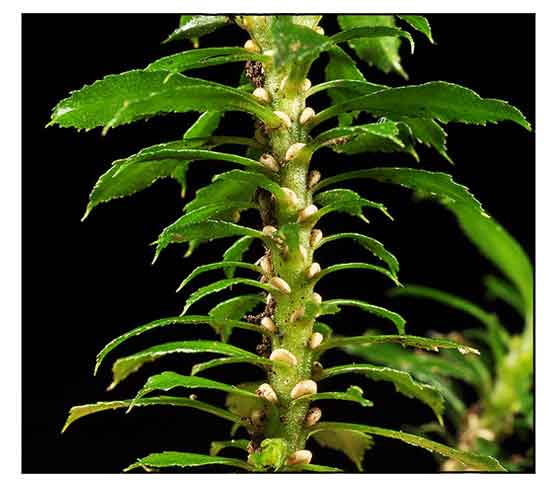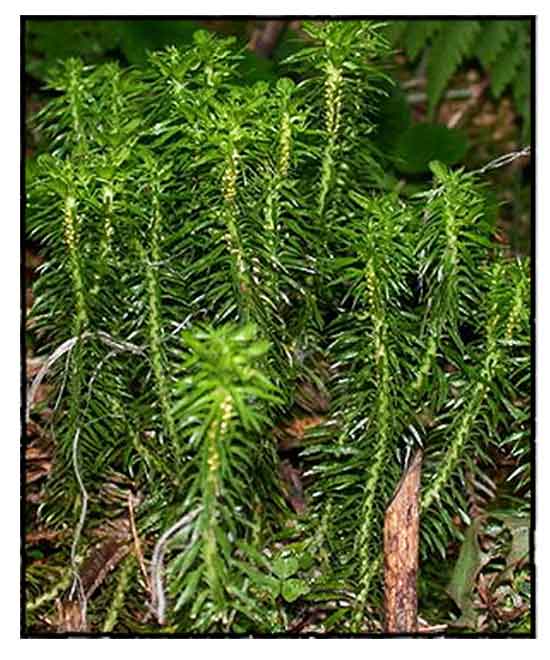 Gen info Gen info
- Huperzia is a genus of lycophyte plants, sometimes known as firmosses or fir clubmosses. The genus was originally placed in the related genus Lycopodium, from which it differs in having undifferentiated sporangial leave, and sporangia not formed into apical cones. (3)
- The genus Huperzia was created by Johann Jakob Bernhardi in 1801, who separated Huperzia from Lycopodium.
- The PPG I classification placed 25 species in the genus Huperzia. As of January 2023, World Ferns listed 61 species, noting "many species still need transfer into other split genera". (3)
Botany
• Huperzia serrata is a terrestrial, moss-like, repeatedly forked herb with serrate leaves and a ragged appearance. Stem erect, decumbent at the base, 3-15(-21) cm × 1-2 mm (not including the leaves), 1-3 times dichotomously branched, green but the older parts yellower. Leaves reflexed near the base, spreading in the younger parts, spirally in many ranks, petiolate; lamina elliptical to lanceolate, 7-17(-30) mm × (1-)2-4(-5) mm, base narrowed, margins deeply irregularly serrate or double serrate, apex abruptly acuminate, deep-green, thin chartaceous, costa distinctly raised above; between the leaves trilobed gemmae may be present. True strobili are absent; sporangia scattered, neither in distinct zones, nor only terminally, on stem parts that are only little different from the vegetative parts of the stem; sporophylls lanceolate, 3-5 mm long; sporangia lunate, wider than the sporophyll bases. Spores trilete, distinctly triangular, concave, truncate. (2)
 Distribution Distribution
- Found from India, the eastern Himalayas to Korea, and through Japan, Taiwan and Indo-china to Indonesia, the Philippines, Polynesia, the Sandwich Islands and Haiti. A secondary disjunct population exists in wet mountain forests in Mexico, Cuba, and Hispaniola. (2)
- Native to
Cuba, Haiti, Hawaii, Japan, Khabarovsk, Korea, Kuril Is., Manchuria, Mexico Northeast, Mexico Southwest, Nansei-shoto, Primorye, Sakhalin. (1)
Properties
- Studies have suggested nootropic, anti-inflammatory, memory boosting, neuroprotective, acetylcholinesterase inhibitory, cognitive enhancing, Alzheimer-preventive properties.
Parts used
Whole plant
Uses
Folkloric
- No reported folkloric medicinal use in the Philippines.
-
In traditional Asian medicine, used for treatment of cognitive dysfunction, dementia, and schizophrenia.
-
In traditional Chinese medicine used for treatment and prevention of dementia.
- Qiancengta (jin bu huang), a traditional Chinese medicine made from whole plant of club moss H. serrata, has been used for various ailments, including contusions, swellings, schizophrenia, myasthenia gravis, and organophosphate poisoning. (5)
Studies
• Huperzine A (HupA) / Neuroprotective Effects: Review reports on Lycopodium alkaloids, and focuses on huperzine A (HupA), a promising therapeutic option for several acute and chronic disorders. Hup A is the foremost Lycopodium alkaloid isolated from Huperzia serrata. The purified alkaloid has been used for neutoprotective effects. It is well tolerated in humans, even a doses well above required clinically. Hup A has been studied for treatment of Alzheimer's disease (AD) and age-related memory decline. Studies have suggested HupA is a more favorable AChE inhibitor than those conventionally used and already approved for AD treatment. On-going studies on HupA suggest potential against chemical weapons (nerve gases), epilepsy, myastheria gravis, neuropathy, and schizophrenia. (4) HupA is a potent, highly specific and reversible inhibitor of acetylcholinesterase (AChE). Compared with tacrine, donezepil, and rivastigmine, HupA has better penetration through the BBB (blood-brain-barrier), higher oral bioavailability, and longer duration of AChE inhibitory action. It has been found to improve cognitive deficits in a broad range of animal models. The neuroprotective effects are related to its ability to attenuate oxidative stress, regulate expression of apoptotic proteins Bcl-2, Bax, P53, and caspase-3, protect mitochondria, upregulate nerve growth factor, and interfere with amyloid precursor protein metabolism. Phase IV clinical trials in China have demonstrated HupA significantly improved memory deficits in elderly people with benign senescent forgetfulness, and patients with Alzheimer disease and vascular dementia, with minimal peripheral cholinergic side effects and no unexpected toxicity. (9)
• Endophytic HupA-Producing Fungus from H. serrata: Study identified and characterized a novel Huperzine A (HupA)-producing fungal strain Slf14 from leaves of H. serrata. The HupA produced by the endophytic fungus was identical to authentic HupA analyzed by thin layer chromatography, HPLC, LC-MS, H NMR and AChE inhibition activity in vitro. The amount of HupA produced by Shiraia sp. Slf14 was 327.8 µgl by HPLC, far higher than other reported endophytic fungi. Although the HupA from endophyte is not very high, it could provide a promising alternative approach for large-scale production of HupA. (6)
• Neuroprotective / Potential Synergism of Hyperzine A and Polyphenols: Huperzine A (HA) of H. serrata is a well-known competitive reversible inhibitor of acetylcholinesterase (AChE) with neuroprotective effects. Study reports on a green one-step method using microwave extraction to generate H. serrata extract, NSP01. The neuroprotectiive activity of NSP01 is based on a precise combination of three major constituents: HA and two phenolic acids, caffeic acid (CA) and ferulic acid (FA). CA and FA potentiated HA-mediated neuroprotective activity. The combination of HA with CA and FA does not potentiate AChE inhibitory property of HGA which is responsible for adverse side effects. The beneficial effects of NSP01, mimicking the traditional H. serrata decoction, were observed at lower doses than usual efficient concentrations of HA, which can reduce the potential cholinergic adverse effect of the molecule. (8)
• Anti-Neuroinflammatory: Overactivated microglia are a chronic source of meaningful neurotoxic factors, and inhibition of microglial overactivation restores neuronal survival, and regularization of microglial activation may slow down or delay progression of neurodegenerative disorders. Study evaluated the anti-neuroinflammatory effect of HsAE (alkaloid-enriched extracts of H. serrata) in LPS-stimulated BV2 microglial cells and its underlying mechanisms. Results showed HsAE is non toxic to BV-2 cells and can even rescue lethal cells upon LPS treatment HsAE treatment reduced NO production, cytokine secretion, and inflammation-related pathways (COX-2, iNOS, and MAPK pathways). Results suggest alkaloid-enriched extracts of H. serrata has potential for the treatment of neurodegenerative diseases. (10)
• Huperzine A / Neuroprotective Molecular Signaling in Alzheimer's Disease: The effects of HupA have been attributed to its ability to inhibit the cholinergic enzyme AChE, acting as an acetyl-cholinesterase inhibitor (AChEI). Study summarizes the neuroprotective effects of HupA on AD, with emphasis on its interactions with different molecular signaling avenues, such as Wnt signaling, the pre- and post-synaptic region mechanisms (synaptotagmin, neuroligins), the amyloid precursor protein (APP) processing, the amyloid-ß peptide (Aß) accumulation, and mitochondrial protection. The study provides an integrated overview of the molecular mechanisms through which HupA affects AD. (11)
• Protective Against Oxidative Damage and Cognitive Dysfunction: The accumulation of amyloid ß (ß) is an important factor in Alzheimer's disease (AD), with its relation to oxidative stress, which could promote neuronal cell death, along with decrease in the concentration of the neurotransmitter, acetyl-choline. Study evaluated the protective effects of H. serrata and its components against neuronal cell death and cognitive dystunction. Murine hippocampal cells (HT22 cells) were damaged by Aß, H2O2 and glutamate. Study identified caffeic acid, ferulic acid, and hyperzine A as major components. Results showed H. serrata and components prevented cell death and decreased production of ROS, and inhibited AChE activity. H. serrata treatment (100 mg/kg p.o.) significantly improved arm alternation and latency in scopolamine-induced cognitive dysfunction and decreased lipid peroxidation in the brain. (12)
• HupA as Alzheimer-Modifying Drug: Studies on HupA have suggested a protective effect on neurons against amyloid beta-induced oxidative injury and mitrochondrial dysfunctions and up-regulation of nerve growth factor and antagonizing of N-methyl-d-aspartate receptors. HupA may reduce brain iron accumulation, further underscoring its potential as a disease-modifying agent for AD and other neurodegenerative disorders by slowing down the course of neuronal death. (13)
• HupA Content / Antioxidant: Study evaluated the antioxidant activity and content of HupA in three different genotypic wild H. serrata. High-performance liquid chromatography analysis showed in vitro culture of the three genotypes could produce HupA with HupA content of 53.90-87.17 µg/g. Methanol extract of in vitro H. serrata showed higher antioxidant activity than that of wild H. serrata. Study provide a reliable in vitro H. serrata culture protocol and foundation for antioxidant capacity of the thallus and content of HypA. (15)
• Neuroprotective on Scopolamine-Induced Neurodegenerative Animals / Alkaloids: H. serrata contains Huperzine A (HupA), an alkaloids used for treatment of cognitive dysfunction. Study evaluated total alkaloids (HsAE) for potential in managing cognitive impairment compared with HupA. In the cellular study, cell viability and level of ACh and SH-Sy5Y cells were evaluated after pretreatment with HsAE and scopolamine. HsAE showed not toxicity to SH-SY5Y cells, and can rescue cells upon scopolamine treatment. HsAE showed neuroprotection against scopolamine-induced amnesia in mice. HsAE decreased AChE activity, MDA level, increased antioxidative enzyme activity in the hippocampus and cortex of mice. Results suggest HsAE may significantly protect neurons of mice with scopolamine-induced memory impairment associated with AChE depletion and oxidative stress. (16)
• Endophytic Fungi with Anti-Acetylcholinesterase Activity: Study for endophytic fungi identified two strains, L10Q37 and LQ2F02, that have antiacetylcholinessterase activity. However, the active compound
Risk assessment and interactions
• Drug Interactions with Huperzine A : HuperzineA (HupA) should not be used when taking other drugs: (1) Acetylcholinesterase inhibitor drugs like donepezil, galantamine, or rivastigmine - the same mechanism of action may increase the risk of adverse effects. (2) Dopamine D2 receptor blocker - Huperzine may cause symptoms of Parkinson's disease. (3) Calcium channel blockers or beta adrenergic antagonists: Huperziine may lower the heart rate. Possible side effects are mild and include nausea, thirst, abdominal pain, anorexia, dizziness, vomiting, constipation, diarrhea, insomnia, excitability, hyperactivity, sweating, slow heart rate, drowsiness, nasal blockage, swelling. (7) Herb-Drug Interactions: (1) CYP450 substrates: May reduce effectiveness of drugs metabolized by the enzyme. (2) Acetylcholinesterase inhibitors (donepezil, galantamine, rivastigmine): May increase risk of adverse events for drugs with acetylcholinesterase inhibition effects. (3) Dopamine D2 receptor blockers: May lead to parkinsonian symptoms. (4) Calcium channel blockers: May produce severe bradycardia. (5) Beta adrenergic receptor antagonists: May produce more severe bradycardia. (16)
• Risk Assessment of Herbal Preparations: A RIVM letter report (2024-0028) published a risk assessment of herbal preparations containing Huperzia serrata, which caution that the herb may be harmful to human health, and advises against use of the herbal preparations, especially during pregnancy. Undersirable effects on the cholinergic system may occur: increased salivation, muscle weakness, abdominal cramps, diarrhea, blurred vision, lacrimation, and paralysis. It warns of harm to unborn child during pregnancy. It cautions that other constituents in H. serrata may enhance the effect of huperzine A. (14)
Availability
- Wild-crafted.
- Teas, plant powder, Huperzine A (HupA) in the cybermarket.
- Huperzine A is marketed as a supplementary drug for correction of memory impairment, under the trade name "Cerebra". It is also marketed as a "smart drug" to boost brain power.
(2) |

![]()





